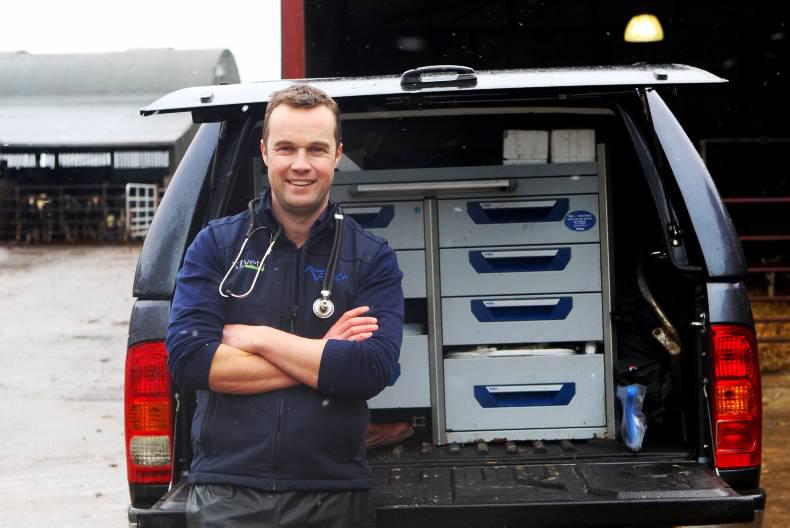I regularly have calls in relation to sheep or lambs not doing well production-wise or performance-wise.
At this time of year, as early lambs are weaned, we regularly see issues around poor performance or ill thrift.
What is a very regular finding along with parasites or pneumonia is trace element deficiencies.
The four main trace elements we see causing problems when they are deficient are copper, selenium, iodine and especially cobalt.
Now this might vary considerably depending on the part of the country you are in, but today I will deal with these four main trace elements and some of the conditions to watch out for, especially in lambs.
Cobalt (Co)
This is a very common defiency in weaned and growing lambs which causes significant reductions in performance.
It has also been linked to poor milk production in ewes and increased lamb mortality.
The principal sign in lambs is ill thrift and a very loose fleece. Sometimes they can also appear anaemic.
One other condition which can have similar signs is acute fluke infestation, but at this time of the year it is unlikely.
Cobalt plays a key role in the production of Vitamin B12 which plays a huge role in liver function and energy production. A lack of cobalt depresses energy and appetite in the weaned lamb. B12 also plays a key role in wool production and this is why it is thought sheep are more prone to cobalt defiency.
At this stage most flocks will know if they are deficient in their area for cobalt. To test for Co in animals can be quite difficult and often requires liver samples for the most accurate analysis.
Many farmers supplement and then wait to see a response to treatment. The options are liquid drenches every three to four weeks, mineral boluses, pasture dressing or mineral trace element boluses at the start of the risk period.
Selenium (Se)
Selenium is quite a complex trace element that is involved with Vitamin E in immune function and muscle function. Now this is over-simplifying its role but it is just a way of trying to understand its role when deficient.
We see big problems with reduced selenium in our flocks but some areas of the country might have a problem with toxicity or too much selenium.
The main clinical signs we see in deficient sheep are ill thrift, poor reproductive performance in ewes or, rarely, white muscle disease.
We usually see these problems affecting lambs towards the back end of the summer or the start of autumn. I myself have seen a lot of problems with early embryonic losses associated with low Se as it plays a key role in reproduction, including sperm function in the ram. So both ewes and rams should be supplemented where needed pretupping.
We now rarely see white muscle defiency due to farmers supplementing selenium around lambing. Defiences can often lead to weak or still born lambs with poor suck reflexes.
In older lambs it can often appear like joint ill with stiffness or breathing difficulties due to respiratory muscle involvement. It can also reduce immune function which may lead to more infections such as pneumonia.
I regularly carry out blood tests which I find as an accurate screen to test for a defiency.
There is lots of supplementing options such as oral Se or short acting injections such as vitesel. Again these oral drenches usually contain Co and B12 and must be given to lambs every three to four weeks. There is also a large range of ruminal boluses available to help supplement lambs for longer periods and ewes pretupping.
Copper (Cu)
One of the common conditions associated with copper defiency in lambs is swayback.
In the last few years, due to meal being fed in late gestation to ewes, we have seen a reduction in the number of cases we see.
These lambs can appear to stagger and can have weak back limbs. However other conditions like spinal abscesses are also a common finding in these lambs.
Like cattle there are a number of things that will bind up CU in soil, pasture or silage. The breed of sheep also can play a role with some breeds such as Suffolk having little problems while the black face seems more prone to Cu defiency.
Again I will blood animals to check for Cu levels and they can be supplemented by several methods. When blood copper levels are low then they need urgent treatment as the liver will store a large amount of copper before blood copper drops.
Again there is an injectable form of copper or an oral form. Most of our flocks will use a ruminal bolus that releases copper slowly. Again some breeds are prone to copper toxicity so supplement only after talking to your vet or advisor.
Iodine (I)
This is a trace element deficiency that again will vary throughout the country. It is one I have seen and diagnosed a lot in cattle this spring.
In sheep it affects ewes around mating and it has also been linked with ewes having stillbirths or weak lambs.
Ewes that are on a diet of fodder/sugar beet, kale or other brassicas while pregnant can be quite low in iodine and may need to be supplemented.
It definitely helps to sample ewes pretupping by blood testing to rule out iodine defiency.
In lambs it plays a key role in thyroid production so can result in weak lambs. In lambs sometimes on post mortem we will see enlarged thyroid glands. Again you can use oral supplements or slow releasing ruminal boluses. I have used off label iodine pour-on to good affect but this is only in one flock.
This is only a brief overview of the trace element defiences that affect sheep and lambs for more information talk to your own vet or/and nutritionist.






 This is a subscriber-only article
This is a subscriber-only article










SHARING OPTIONS: